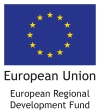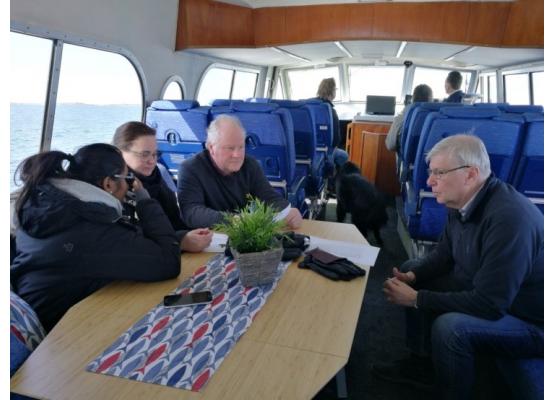In English
To build a successful partnership - the PortMate example
This is an interview from spring 2017 with project manager Minna Keinänen-Toivola from the Lead Partner (SAMK) and Peter Wåglund respresenting Gävle municipality, one of the project partners, after the first six months of project implementation.
- Why did you want to have a project like PortMate?
M: We are in Rauma, in the archipelago, so we were interested in how we could improve the small ports in our region and have the benchmarking with Sweden and Åland. SAMK has the expertise on safety in small ports and resource efficiency.
P: We are a coastal town and want to increase tourism also from the seaside. For the moment a large renewal of the guest port in Gävle is going on, and PortMate matches this internal project very well. We also collaborate much with other coast towns in our region, and we’d like to carry on this joint work. Rauma is a twin town of Gävle, which is also a reason for collaboration.
- How did you form your partnership?
M: We knew the city of Rauma, but when it comes to the partners from Sweden and Åland – I have to say, that you (=Contact Point Åland, Ester) have been the very key, because you had the contact information to Gävle and Söderhamn. We had this partner meeting between the first step application. So it was not about having some system in the internet, but you told us. And Sottunga was partner in our former application, which was not accepted, and then Havspaviljongen came, so you have really been the one who brought us together.Of course there is a connection between Rauma and Gävle, because they are sister cities, but they have not been cooperating in the small ports area. So you helped us to find motivated partners.
P: We had been in meetings in Stockholm to try to form a partnership, but we could not come to a common understanding of exactly what to do, neither did we find a suitable Lead Partner. When we started to think that there will not be a project, an invitation came from SAMK. It was a relief, that they offered themselves to take the lead, and we thought the partners were important to us; especially Söderhamn, that we often cooperate with in projects, and Rauma, our twin city in Finland. We did not have connections to Åland partners before, but they seemed to suit well into the partnership (which they have also proven to be).
- Why do you want to work with people from different countries/regions in a cross-border project?
M: By benchmarking you learn about the procedures, how to do things differently or better, so it is also much more cost efficient. Under this first period we have learned more about different organizations, insurances, how boat associations work in Sweden, and other small practical things about how things are working.
- What are the results so far?
M: We are now at the end of the first period, so we have had our starting actions. And so far the focus has been on the safety, we have had a workshop in Gävle, where also stakeholders were participating. And we have made a questionnaire to port users (363 answers) and one to port operators (38) on the safety issue in the Central Baltic region.
And that is really good. We are finalizing the report now, and there are really interesting results. The expectations differ between these two groups.The results and our expertise will be summarized in a check list for a “Perfect small port in safety”, and also for the sailors.
P: The results are the same as for SAMK (see above), but we have also had some internal issues forming a local working group, finding staff for the project and organizing the work between different departments and a municipal company in Gävle municipality. Things are somewhat clearer now, but it has been tough to organize the internal work.
You can see that the questions we are dealing with are important to seafarers, and during the workshops participants were very engaged. This means that there is a need for the project.
- How are you reaching your target group/end users?
M: They have been invited to our workshops and have been reached with our questionnaires – by different channels in Finland and Sweden, we have used Face Book announcements, leaflets and personal contacts. This is however a work, that can and will be improved during next periods.
- Do you think people around understand that EU is financing these actions and improvements?
P: Yes. It is mentioned in articles, for example in Gefle Dagblad and in local TV, where I was underpinning it. But it is a work that has to go on continuously; people in Sweden still need to know more about EU intervention in regional development work.
M: And the flag is everywhere.
- What has been easier than you expected?
M: I must say I am quite happy with the benchmarking of the small ports. People have been so anxious, they have different backgrounds, and they don’t need to be experts, but they are still doing the work together. And the questionnaire went well, and the cooperation with the Swedish partners there.
P: To form the project partnership (the international one) and to start the learning processes between us. It was also easier than I thought to get interested participants to the workshops in Gävle, even though they took one whole day.
- What has been more difficult or challenging than you expected?
M: It is about the management for the whole Central Baltic programme. We have also project Waterchain from the First Call, and now we see that the expectations from the programme have been very exact (the salaries, the state aid, etc). But then I think it is public money, and it has been a learning process also in the secretariat.
P: I fully agree with Minna. It has been a tremendous work to reach the project start and it took about 5 months before the Partnership Agreement could be signed. I think there are such things, on super detailed levels, that make people so annoyed about EU projects, not the fact that it is taxpayers’ money.
- What are you most proud of?
M: From our side, this is the largest project we are leading so far, 2, 7 million euros. That really makes me proud that we manage to handle it - and the whole team, a very nice team.
P: That we managed to make it the whole way through the application stage. It took about 1, 5 years from first planning meetings until an approved project.
- What do you think will remain, when the project is over?
M: The results of the investments, and I really hope that one thing is this ICT tool, the partnership and network – we have got new friends, - and hopefully the best practice for both the port operators and for the small port users, so that they know that they can visit more places and how to sail safely. We have 19 small ports, and we are doing videos about the ports, guidance to come there, the safety in the small ports, the first aid, etc.
P: For Gävle I hope it will mean that more visitors (also from the sea) will visit and explore Gävle.
- Something else you want to add?
M: In this project we planned for many physical meetings face to face during this first period, and it has been really needed. It is valuable to learn to know each other in the beginning both through open discussions and joint travels during this benchmarking to the pilot small ports. It facilitates the planning, work and joint actions afterwards.



